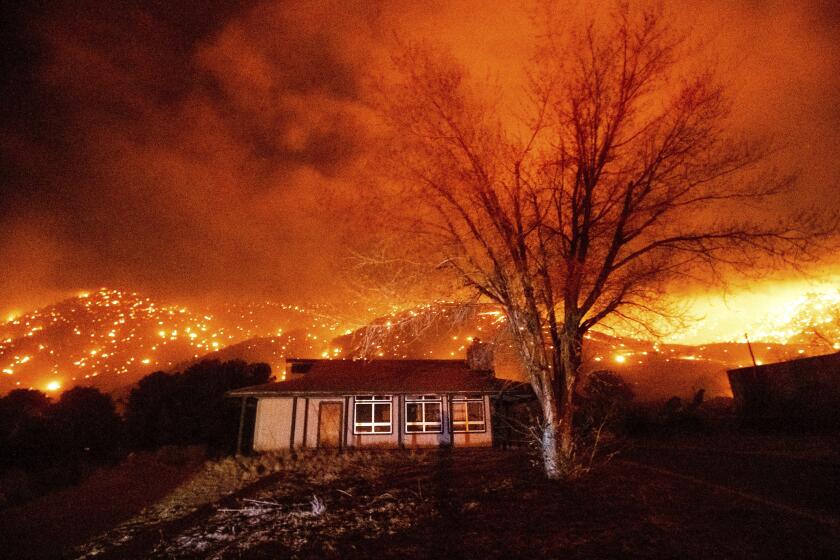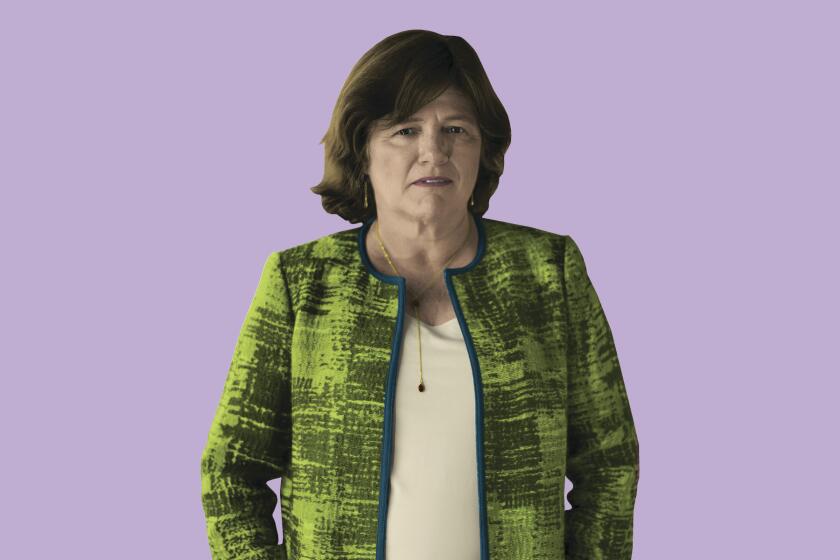If you live in a fire-prone part of California, this road map can help you save on insurance
- Share via
With the fire season growing longer and wildfires increasing in intensity, Californians living in fire-prone areas are having a harder time finding affordable insurance for their homes — if they can find coverage at all.
With that in mind, state officials unveiled a “Safer from Wildfires” framework this week for improving fire safety and reducing losses. The goal is not just to save lives, but also to hold down premiums and make coverage available in more areas.
The framework lays out a list of upgrades that individual homeowners should make and preventive actions that local governments and community groups should take. Rather than breaking new ground on fire safety, it draws from the best practices outlined by the consumer group United Policyholders, the Insurance Institute for Business & Homes Safety and Cal Fire, among others.
Many of the items on the list are already required for homes being sold or new homes built in neighborhoods with an elevated risk of fire. And some of the recommended upgrades are costly, albeit less so than a blaze that destroys your home.
The recommendations are the fruit of an effort started a year ago by Insurance Commissioner Ricardo Lara and several state agencies involved in firefighting and prevention.
Today, Lara said, 13 insurers with 40% of the market in the state are offering discounts to homeowners who have made fire-related safety improvements or who live in communities that have done so. His office is weighing regulations that could require more insurers to follow suit, with the new framework potentially serving as a benchmark for determining who qualifies for lower rates.
Drought, climate change and an early start to fire season mean this fall could be one of fire, smoke, poor air quality and evacuations in Southern California. Here’s how you can prepare now.
The state is also putting more money into helping communities and homeowners meet the standards laid out here.
Here are the framework’s recommendations.
Making houses more fire-resistant
There are six recommended structural upgrades to “harden” your home against wildfire risk, and specifically the risk that your house will be set ablaze by burning trees or buildings nearby or by embers blown in from a distance. Some of these carry price tags north of $10,000, while others are do-it-yourself jobs. The steps are:
- Installing a roof rated Class A for fire resistance. For an explanation of the qualities that make a roof Class A, see the U.S. Department of Agriculture’s Surviving Wildfire site or the Homeowner’s Wildfire Mitigation Guide posted by the University of California.
- Creating a 5-foot-wide zone around the house that resists burning embers, for example by laying down gravel or stone walkways in place of mulched flower beds.
- Removing combustible material, such as untreated siding, from the bottom six inches of exterior walls.
- Blocking the entry of burning embers by covering vent openings with fire-resistant metal screens.
- Installing double-paned windows or fire-resistant shutters. Single-paned windows may not stop the heat from an intense fire from setting your curtains on fire and burning down your house.
- Enclosing the eaves to prevent burning embers from drifting into your attic.
For more detailed suggestions, consult Cal Fire’s “Hardening Your Home” site, its low-cost retrofit list and the University of California’s preparing your home webpage.
Get earthquake-ready in six weeks
From building a kit to buying insurance, our Unshaken newsletter course will help you prepare.
You may occasionally receive promotional content from the Los Angeles Times.
Reducing risks near your home
The framework calls for three types of improvements to the property around your house, most of which include things you can do on your own. They are:
- Clearing vegetation, debris and other combustible material — think “tinder” — from under your decks.
- Moving sheds or other combustible structures at least 30 feet away from the house. (Don’t worry — garages don’t count.)
- Complying with state and local requirements for “defensible space” around the home, which means trimming trees, clearing dead vegetation and reducing the amount of potential fuel for a fire.
Taking community-wide action
Lara noted Monday that a homeowner’s safety upgrades can be undermined by neighbors who ignore the hazards on their own properties. So community-wide efforts are crucial.
The framework lays out the following “mitigation elements” for communities to adopt:
- Clearly defining the community’s boundary, then obtaining an assessment of the community’s fire risk from the local fire district or the state fire agency.
- Identifying an evacuation route that is kept clear of overgrown vegetation, along with a contingency plan.
- Finding the financial resources to support the upgrades needed to meet “clear risk reduction goals.” Cal Fire offers fire prevention grants that can pay for clearing firebreaks and removing combustible material, but the dollars are available only to governmental agencies, tribal groups and nonprofits.
- Developing plans with measurable annual goals for reducing the community’s wildfire risks, as well as steps to increase the awareness and education of community members regarding those risks.
Currently, 10 insurers are offering community-based discounts to homeowners, although they aren’t all using the same criteria. The new framework puts forward a standard that all insurers could use to judge a community’s mitigation efforts.
People are much more important than kits. People will help each other when the power is out or they are thirsty. And people will help a community rebuild and keep Southern California a place we all want to live after a major quake.
Where to find help
A good place to start is with your local fire safe council, which you can locate on the California Fire Safe Council website. These groups draw up wildfire plans, educate local homeowners about prevention and tackle larger projects to protect their communities, such as clearing brush and creating firebreaks.
For example, the Meadows Fire Safe Council in Altadena offers to inspect properties and let homeowners know what safety improvements they should make, said the group’s spokesman, Bill Ramseyer. In addition, he said, “we will help people do the work, in terms of physically having our people come by with the chain saws and the weed whips.”
That help, however, won’t extend to replacing someone’s roof or windows, Ramseyer said.
Amy Bach, executive director of United Policyholders, said one challenge for homeowners is the lack of funding for that sort of costly improvement to an individual property.
The California Office of Emergency Services is providing grants to local agencies to help low- and moderate-income homeowners with wildfire mitigation projects, but they’re confined at this point to pilot programs in San Diego and Shasta counties. The agency says it is aiming to take the program statewide in 2023.
In the meantime, the agency has a $100-million grant program to help vulnerable communities obtain federal aid for a variety of disaster-related purposes, including creating defensible space and retrofitting structures. As with the wildfire mitigation grants, money flows to local governments and organizations, not directly to individuals.
Some counties have taken matters into their own hands, creating funds to help homeowners directly. One example is Marin County, which approved a special tax in 2020 to fund a new county wildfire prevention authority. That group offers grants for home hardening and defensible space projects.
Buy a portable air filter in advance of fire season, one expert said, ‘because once there’s a fire and the smoke is bad, then there’s a run on them.’
More to Read
Inside the business of entertainment
The Wide Shot brings you news, analysis and insights on everything from streaming wars to production — and what it all means for the future.
You may occasionally receive promotional content from the Los Angeles Times.














